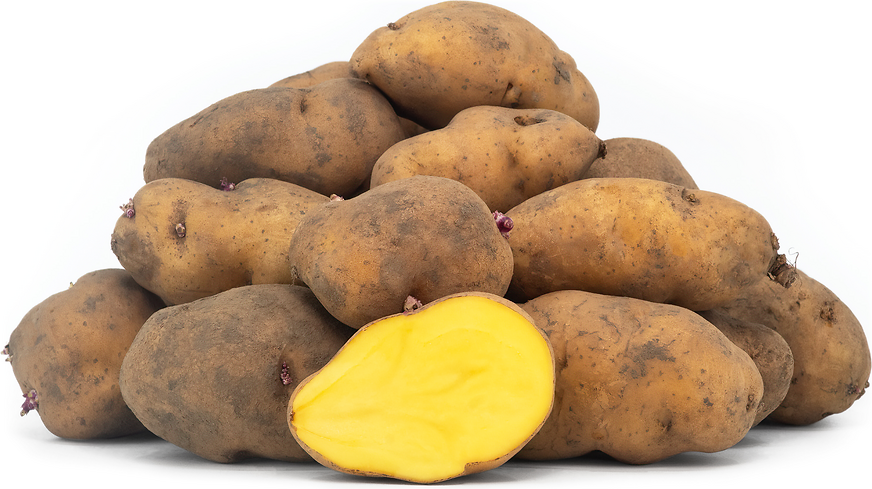


Paola Potatoes
Estimated Inventory, lb : 0
Description/Taste
Paola potatoes vary in size and shape, depending on growing conditions, and have a distinctly elongated, elliptical, or oval appearance with blunt, curved ends. The semi-thin skin is smooth, taut, and lightly textured, appearing in variegated shades of golden yellow and brown with dark brown markings. The tubers are also often sold in markets covered in a layer of dark brown-black soil. Paola potatoes have shallow, superficial eyes that do not affect the overall shape. Underneath the surface, the rich, golden-yellow flesh is dense, firm, and slippery when raw, becoming soft and tender when cooked. Paola potatoes have a high dry matter content and remain somewhat firm and creamy in culinary preparations. The variety is only edible cooked and has an earthy, subtly sweet, and nutty flavor.
Seasons/Availability
Paola potatoes are available year-round.
Current Facts
Paola potatoes, botanically classified as Solanum tuberosum, are a Colombian variety belonging to the Solanaceae or nightshade family. The late-season cultivar was commercially released in the early 21st century and was chosen as an improved variety for its favorable culinary qualities, productive nature, and distinct shape. Paola potatoes are also known for their disease resistance, especially to Phytophthora infestans, a fungus commonly referred to as late potato blight. This disease can be one of the most destructive forces against commercial potato crops. The Paola potato’s resistance to late blight allows farmers to use more natural cultivation methods, and the variety produces high yields. Paola potatoes were one of four varieties developed by the National University of Colombia in a breeding program focused on flavor and disease resistance. The tubers are valued for their minimal waste in savory culinary preparations throughout Colombia. They are also used in processing as their elliptical, elongated shape creates uniform slices. Paola potatoes are still in their initial commercialization phases and are currently limited in availability throughout Colombia.
Nutritional Value
Paola potatoes have not been extensively studied for their nutritional content. Like other yellow-fleshed varieties, the tubers may be a source of iron, vitamin C, zinc, and potassium. Iron develops the protein hemoglobin for oxygen transport through the bloodstream, while vitamin C strengthens the immune system. Zinc assists the body’s metabolism, and potassium balances fluid levels while replenishing electrolytes. Potatoes also provide fiber to regulate the digestive tract, calcium to protect bones and teeth, phosphorus to repair tissues, magnesium to control nerve functions, and other nutrients, including copper and manganese.
Applications
Paola potatoes have an earthy, neutral, sweet, and subtly nutty flavor suited for cooked preparations. The variety is versatile and can be used in any recipe calling for yellow-fleshed or creole potatoes. Paola potatoes are promoted for their ability to make crispy chips as the elongated tuber shape creates uniform slices. The tubers are also boiled and tossed with herbs and sauces as a simple side dish, cut into pieces and roasted, or sliced and layered into casseroles. In Colombia, Paola potatoes can be incorporated into sancocho, one of the most popular soups prepared in the country. Sancocho is comprised of herbs, root vegetables, spices, and meat and is served with rice and avocado. Paola potatoes are also used in ajiaco, another savory soup of potatoes, chicken, and spices. In addition to soups, Paola potatoes can be made into purees, cooked into fries, or served roasted as a simple side dish to grilled meats. Paola potatoes pair well with spices such as paprika, cumin, and cayenne, meats including poultry, beef, and pork, tomatoes, carrots, bell peppers, corn, and legumes. Whole, unwashed Paola potatoes will keep for several weeks when stored in a cool, dry, and dark location.
Ethnic/Cultural Info
The National University of Colombia, UNAL, was famously granted a breeder’s certificate for Paola potatoes by the Colombian Agricultural Institute, ICA. The institute recognized that Paola potatoes were developed through scientific advancements to create an improved variety with distinct, stable, and favorable characteristics. The Colombian Agricultural Institute is a government organization aimed to help protect agricultural endeavors throughout Colombia. Varieties that receive a breeder’s certificate must pass several technical and comprehensive examinations, and the National University of Colombia was granted a breeder’s certificate for Paola potatoes, which stands for twenty years. Breeder’s certificates are part of a movement to encourage future generations to continue working in the advancement of agriculture. These certificates are said to help reward the efforts of breeders through fair compensation, and growers must obtain approval to plant the variety from the breeder to ensure the quality of the variety is maintained.
Geography/History
Paola potatoes are native to Colombia and were developed through breeding programs at the National University of Colombia. The variety was created from a cross between Criolla Paisa and a variety named S. Phureja Col-3 and was bred by Jose Miguel Cotes Torres and Carlos Eduardo Nustez Lopez. During this breeding project, the university’s primary objective was to create new potato varieties with improved flavor and disease resistance. Paola potatoes were commercially released in 2015 and are being developed in Colombia. The variety is still considered new and can be somewhat challenging to find, but the potatoes are increasing in production for fresh and processed purposes. Today, Paola potatoes are ideal for growing regions between 2400 to 2800 meters above sea level and are primarily grown in the mountains of Nariño and Cundinamarca in Colombia. When in season, harvested tubers may be found through local markets or directly through growers.




